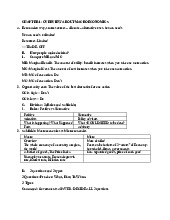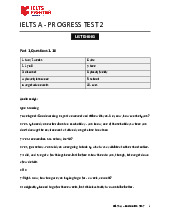







Preview text:
TRƯỜNG ĐẠI HỌC NGOẠI THƯƠNG CSII TP.HCM ……. ***…….
MID-TERM ASSIGNMENT TOPIC: RISKMENT MANAGING PLAN
Instructor: Đặng Thị Mỹ Dung
Subject: English 4 – Market Leader Class code: ML152 Group: Circus Đào Quang Huy 2011116402 Trương Chí Bảo 2011116321 Lý Gia Huy 2011116405 Hoàng Thủy Tiên 2011116585 Lê Bá Nhật Tiến 2011116586 Lê Khánh Trình 2011116605
March 2022, Ho Chi Minh City Contents
1. Overview of risk management. . . . . . . . . . . . . . . . . . . . . . . . . . . . . . . . . . . . . . . . . . . . . . . . . . . . . . 2
1.1. What is risk management?. . . . . . . . . . . . . . . . . . . . . . . . . . . . . . . . . . . . . . . . . . . . . . . . . . . . . . . 2
1.2. The main purpose of risk management. . . . . . . . . . . . . . . . . . . . . . . . . . . . . . . . . . . . . . . . . . . . . 2
2. The role and benefits of risk management for businesses. . . . . . . . . . . . . . . . . . . . . . . . . . . . . . . . 3
2.1. Helping businesses come up with the right strategies. . . . . . . . . . . . . . . . . . . . . . . . . . . . . . . . . . 3
2.2. Help proactively respond to the risks that will inevitably come. . . . . . . . . . . . . . . . . . . . . . . . . . 3
2.3. Limit wasteful use of budget in investment. . . . . . . . . . . . . . . . . . . . . . . . . . . . . . . . . . . . . . . . . . 3
2.4. Is an effective tool in business investment. . . . . . . . . . . . . . . . . . . . . . . . . . . . . . . . . . . . . . . . . . .3
3. Basic risk management process in the business. . . . . . . . . . . . . . . . . . . . . . . . . . . . . . . . . . . . . . . . 3
4. Mistakes when managing risk in the business. . . . . . . . . . . . . . . . . . . . . . . . . . . . . . . . . . . . . . . . . 4
5. Vietravel and their strategy for risk management plan. . . . . . . . . . . . . . . . . . . . . . . . . . . . . . . . . .4
External Risks. . . . . . . . . . . . . . . . . . . . . . . . . . . . . . . . . . . . . . . . . . . . . . . . . . . . . . . . . . . . . . . . . . . . 4
Objective Factors. . . . . . . . . . . . . . . . . . . . . . . . . . . . . . . . . . . . . . . . . . . . . . . . . . . . . . . . . . . . . . . . . 5
Risks due to airline cancellation/postponement affecting tour schedule and services provided to
customers. . . . . . . . . . . . . . . . . . . . . . . . . . . . . . . . . . . . . . . . . . . . . . . . . . . . . . . . . . . . . . . . . . . . . . . 5
Customer-related risks. . . . . . . . . . . . . . . . . . . . . . . . . . . . . . . . . . . . . . . . . . . . . . . . . . . . . . . . . . . . . .5
Subjective risks from employees. . . . . . . . . . . . . . . . . . . . . . . . . . . . . . . . . . . . . . . . . . . . . . . . . . . . . .5
REFERENCES. . . . . . . . . . . . . . . . . . . . . . . . . . . . . . . . . . . . . . . . . . . . . . . . . . . . . . . . . . . . . . . . . . . . 6 1
1. Overview of risk management
Planning is very crucial in our life, especially when we need to plan for a long-term
campaign or an important event. However, even the most well-prepared plan could run into
trouble. No matter how well you plan, you can always encounter problems, especially on the
on-site day. So is it inevitable trouble? Does it mean that we can’t do anything? The answer is
the opposite of what you think. We need to know how to deal with these issues and use the
“risk management” plan for these situations.
1.1. What is risk management?
Risk management is the process of identifying, analyzing, and proposing ways to
handle risk factors that have been, are, or may happen to businesses in the future. This
concept is often used in the sense of risk control in future events, knowing in advance
will help businesses proactively prevent rather than want to respond and handle after everything has happened.
Risk in an enterprise is often understood as a situation or event that can directly or
indirectly affect the operation process and achieve the set goals of an enterprise. These
risks can come from a variety of sources, including financial uncertainty, liability,
strategic management errors, accidents, or natural disasters, and more.
In addition, risks can also come from the business itself, related to some management
issues, corporate culture, remuneration, etc. , or from economic fluctuations such as
development trends, development, consumer trends, or technological developments.
1.2. The main purpose of risk management -
Build a safe and secure working environment for all employees and customers. -
Ensure stability for business activities of the enterprise. -
Protect your business from harmful economic fluctuations or environmental risks. -
Prevent and minimize liability. -
Protect all concerned and property from serious loss. -
Save on unnecessary insurance premiums. -
Determine which risks need to be addressed first, which need to be addressed later.
1.3. Factors that affect risk management - Size of the business. - Current business capacity. -
The operating structure of the enterprise is simple or complex, with more or less potential risks. -
Management and leadership level. 2
2. The role and benefits of risk management for businesses
2.1. Helping businesses come up with the right strategies
Risk management is directly related to the business strategies of the enterprise and
the managers will be responsible for this. If it is possible to predict risks correctly,
managers can make better and more effective decisions to achieve the set goals.
2.2. Help proactively respond to the risks that will inevitably come
For businesses, risk assessment and management is the best way to prepare for
eventualities that may or may not occur during growth and development. When risks
occur, businesses that implement good risk management will limit falling into a passive situation.
2.3. Limit wasteful use of budget in investment
Risk management will show exactly the costs incurred in the process of investing and
operating the business. Thereby, businesses will get an overview of investment and
business activities and eliminate unnecessary costs.
2.4. Is an effective tool in business investment
Successfully implementing the risk management system means that the enterprise
already has a useful tool that can create more business value and bring in new revenue
streams. In addition, risk management activities also help increase the success rate of
projects in which enterprises are investing.
3. Basic risk management process in the business
Step 1: Establish the context for the risks
Enterprises need to anticipate all possible situations in the future. Here it is necessary
to establish the evaluation criteria and define the structure of the analysis. Step 2: Identify risks
In this step, you need to understand the business environment, learn market
information to accurately determine the risks that the business may face. Then sort and
sort them according to a specific list. Step 3: Risk analysis
Once specific types of risks have been listed, the business will continue to determine
their likelihood of occurrence and the consequences they bring. The goal of risk analysis
is to better understand each particular case of risk and how they affect the company's projects or goals. Step 4: Risk assessment
After the overall likelihood of the risk has been determined, along with its overall
consequences. Enterprises need to consider and make decisions about whether the risks 3
are acceptable or not, the probability of occurrence of each risk in order to find the most effective solutions. Step 5: Minimize risk
Based on the results of the risk assessment, companies need to plan to mitigate the
consequences using specific risk control measures.
Step 6: Monitor new and existing risks
Part of the mitigation plan includes continuously monitoring new and existing risks and updating accordingly.
Step 7: External consultation
Internal and external shareholders need to be involved in the discussion and
consultation at each step of the risk management process related to the entire process.
4. Mistakes when managing risk in the business
Apply past events to manage future risk
Risk managers often use results and research from things that have happened in the
past to impose on current problems. This is a way that is not always correct.
Although they have the same conditions, the same subjects, it is not certain that the
risks have happened exactly the same and the solutions are the same.
Do not listen to what is said to be “should not”
“Don’t” advice is often much more practical than “should” advice. Also, the attitude
of disregarding the advice that warns of the negative has made it difficult for companies to control risk.
There is no exact answer to the risks
Risk is an ever-changing factor. Therefore, assumptions and predictions about risks
must also be updated and changed regularly to cover all possible problems in many times.
5. Vietravel and their strategy for risk management plan
Vietravel is one of Vietnam's largest travel businesses. With more than 26 years of
experience in such a competitive market, their risk management strategy comprises the following: External Risks
They are the inevitable problems that many travel agencies have to mention in their
contract when discussing with customers. For example, the political crisis happening in
Thailand in 2009 and 2014 caused several damages for many fields, including aviation.
Tourists were unable to return to their home nations by plane. Finally, Vietravel agreed to
use highways in border areas to bring every tourist home. 4 Objective Factors
The application time of visa is earlier, the visa payment time is close to the flight
time, etc. are considered to be objective factors. They are all pop-up situations that take
lots of time, people, and money from the company. Tourists waste time waiting for the
issue to be resolved, and both become less active as a result. It is caused by visa
restrictions in some local areas, which causes the company's operational costs to rise.
Therefore, it is necessary to ask more deeply about the visas of the customers.
Risks due to airline cancellation/postponement affecting tour schedule and services provided to customers
Besides the airline's reimbursement and support policies, Vietravel also provides
cancellation/postponement scenarios to minimize the damage committed to customers. In
addition, there are many risks arising such as traffic jams, traffic accidents, damaged
vehicles, theft of property, and so on. Customer-related risks
Some situations such as customers do not comply with regulations on aviation, flight
safety, and violate the law in other countries or arise diseases, accidents, etc. called
Customer-related risks. Vietravel will coordinate with all destination branches of the
company or with the processing partner to solve it on time.
Subjective risks from employees
For those risks such as: not following the correct process of advising customers on
policies, regulations, and procedures, etc. Vietravel solves that mainly through their
training projects. They have annual training sessions not only on business knowledge but also on law and other skills.
In addition, Vietravel is also digitizing the operation process to ensure that they do
not leave out any inspection and re-inspection stages when committing to customers.
Creating many scenarios to have lessons learned are also Vietravel strategies to be more prepared in every situation. 5 REFERENCES
1. Your Article Library. 2022. Essay on Risk Management: Meaning and Approaches |
Foreign Exchange. [online] Available at:
/www.yourarticlelibrary.com/business/risk-management/essay-on-risk-
management-meaning-and-approaches-foreign-exchange/98517> [Accessed 14 March 2022].
2. 2022. Introduction: Risk and Management Risk Management Essay. [online] Available
at: /www.majortests.com/essay/Introduction-Risk-And-Management-Risk-
Management-557241.html> [Accessed 14 March 2022].
3. Daotao-vhttdl.vn. 2022. Tin tức - Sự kiện - QUẢN TRỊ RỦI RO TRONG KINH DOANH
DU LỊCH, KHÁCH SẠN - VÍ DỤ TẠI TỔNG CÔNG TY VIETRAVEL. [online] Available at: [Accessed 14 March 2022]. 6
Document Outline
- TRƯỜNG ĐẠI HỌC NGOẠI THƯƠNG CSII TP.HCM
- MID-TERM ASSIGNMENT TOPIC: RISKMENT MANAGING PLAN
- Group: Circus
- 1.Overview of risk management
- 1.1.What is risk management?
- 1.2.The main purpose of risk management
- 1.3.Factors that affect risk management
- 2.The role and benefits of risk management for busin
- 2.1.Helping businesses come up with the right strategi
- 2.2.Help proactively respond to the risks that will in
- 2.3.Limit wasteful use of budget in investment
- 2.4.Is an effective tool in business investment
- 3.Basic risk management process in the business Step
- Step 2: Identify risks
- Step 3: Risk analysis
- Step 4: Risk assessment
- Step 5: Minimize risk
- Step 6: Monitor new and existing risks
- Step 7: External consultation
- 4.Mistakes when managing risk in the business Apply
- Do not listen to what is said to be “should not”
- There is no exact answer to the risks
- 5.Vietravel and their strategy for risk management p
- External Risks
- Objective Factors
- Risks due to airline cancellation/postponement aff
- Customer-related risks
- Subjective risks from employees
- Group: Circus
- REFERENCES



